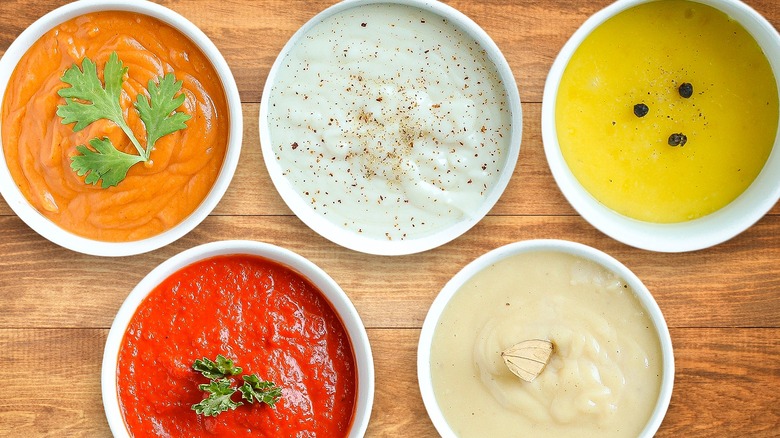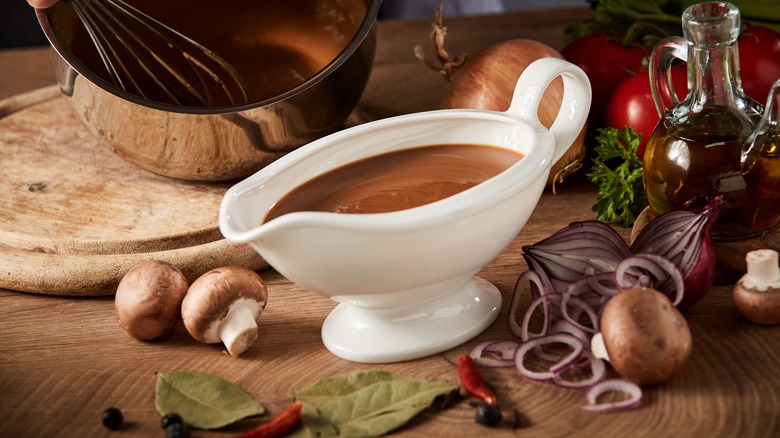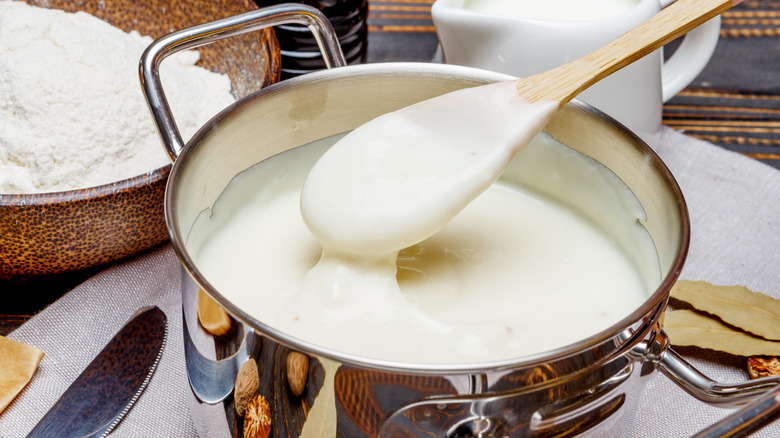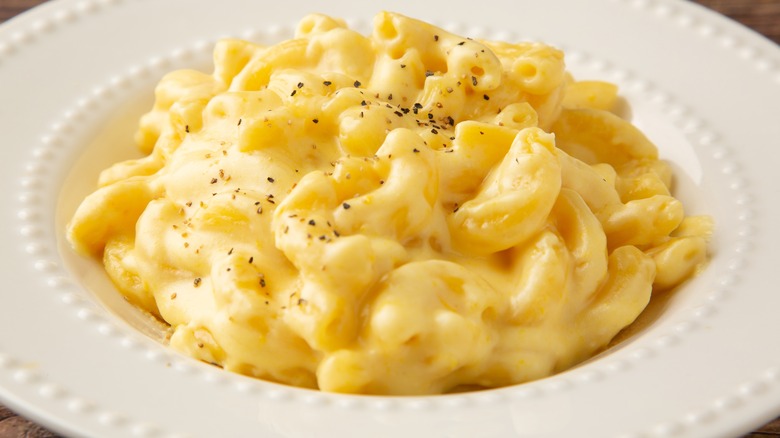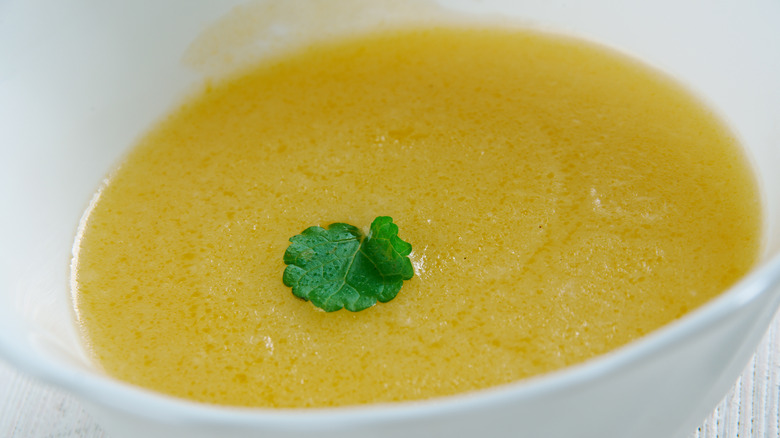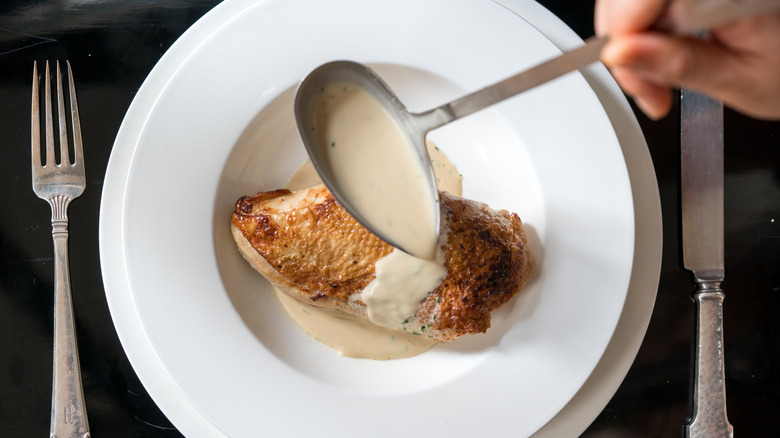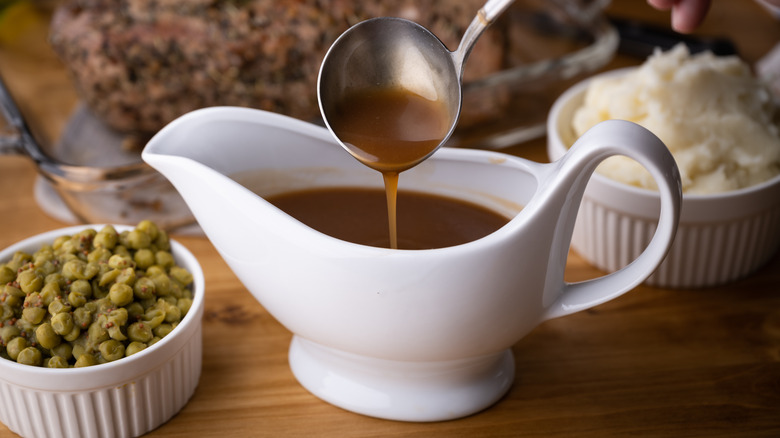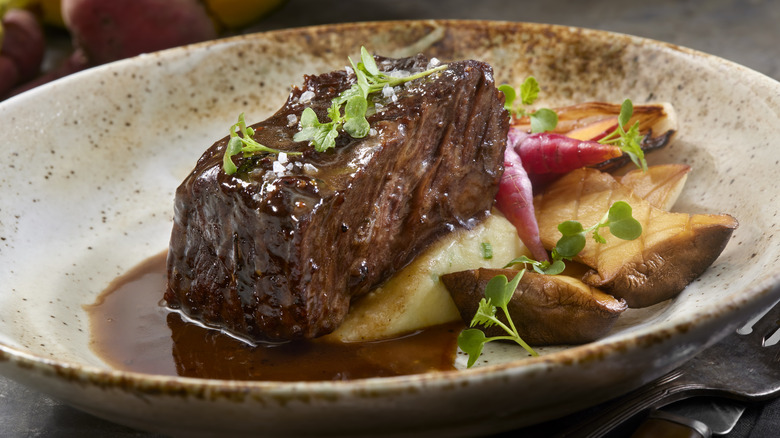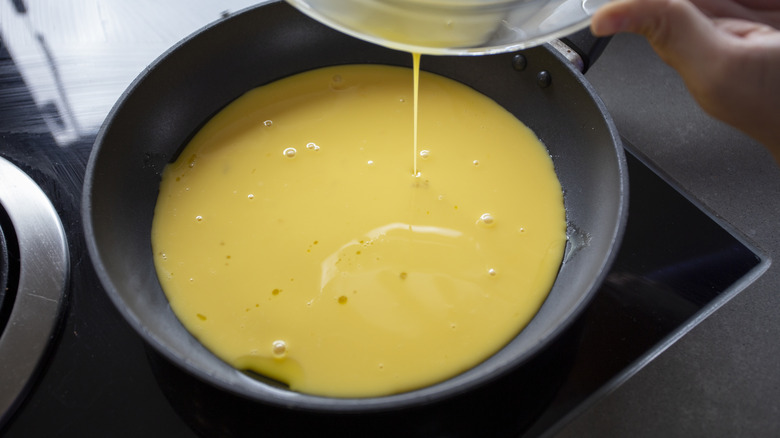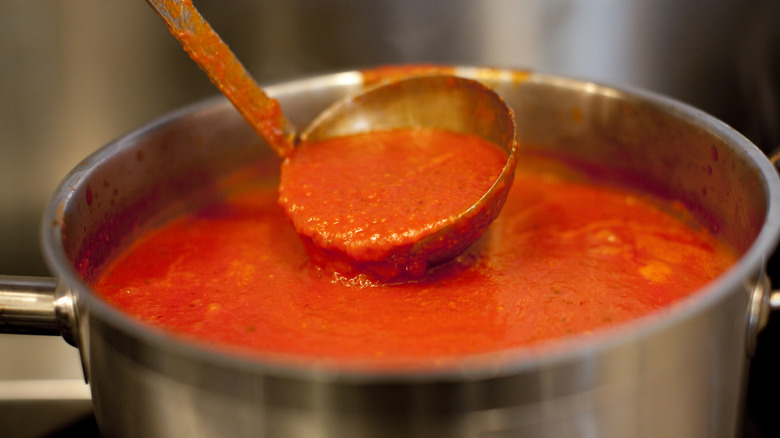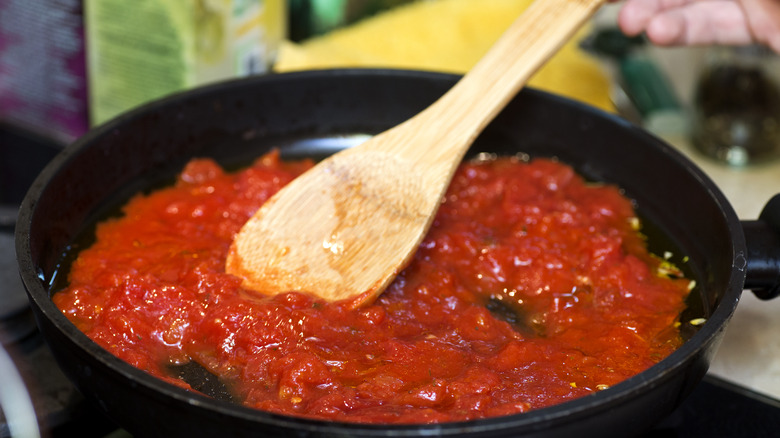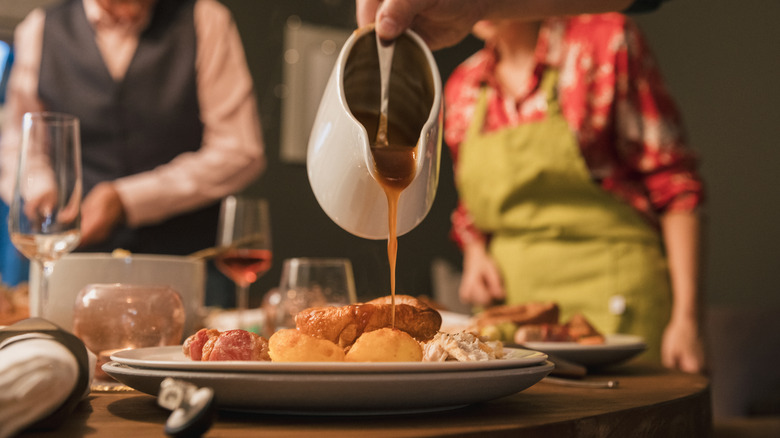Your Complete Guide To The Five Mother Sauces
Unless you're a seasoned cook, the idea of the five mother sauces may sound intimidating — if you've heard of them at all. You may know that they're a foundational part of classic French cuisine, which is enough to make them seem scary to an ordinary American home cook. Adding to the intimidation factor is the vaguely authoritarian tone of the name: why are they called the mother sauces, and who decided there should be exactly five? Furthermore, if there are five mother sauces, doesn't this imply the existence of a bunch of baby sauces?
It's not as complicated as it may seem. The concept of mother sauces is intended to make cooking easier — not harder. Put simply, by knowing how to make five basic sauces with different flavor profiles –- béchamel, velouté, espagnole, hollandaise, and tomato -– you have the tools to make dozens of other sauces just by tweaking a few ingredients. There are indeed baby — or as the French would call them — small sauces or daughter sauces. Even if you're unfamiliar with their French names, you've almost certainly tasted variations of all these as part of familiar dishes including macaroni and cheese, lasagna, and even hearty braises such as pot roast. With the help of Ashley Lonsdale, chef-in-residence at ButcherBox, and Eric Tiglao, executive chef at Taureaux Tavern in Chicago, we're here to demystify the five mother sauces so you too can create classic sauces like a mother.
Origins of the five mother sauces
French cooks have always taken their work seriously, and for centuries, chefs in France have developed and refined cooking methods and organizational systems to make kitchens run efficiently and make their food even tastier. The concept of mother sauces was among these innovations. "The French mother sauces were popularized in the 19th and 20th centuries by Marie-Antoine Carême and Auguste Escoffier, respectively," Ashley Lonsdale explained. "They've stayed true to their roots over the years!"
It took some time, however, for the selection of mother sauces to evolve into its current form. When Carême first proposed a set of master sauces in the early 19th century, he included only four: velouté, béchamel, allemande, and espagnole sauces. In the early 20th century, Escoffier decided that allemande sauce –- a thickened sauce based on veal stock and enriched with egg yolks and cream –- should be considered a daughter sauce of velouté, rather than a mother sauce in its own right. He also added two more sauces to the inventory, hollandaise and tomato sauce, giving us the five mother sauces that all classically trained French cooks know and use today.
Béchamel sauce
Even if béchamel sauce is unfamiliar to you, you've almost certainly tasted it or a close variation of it. "Let's remember that the mother sauces are not just for elevated dishes. One of the most classic uses of béchamel is the base of the sauce for macaroni and cheese!" Ashley Lonsdale said. "It's also an essential sauce for moussaka and sausage gravy."
One reason béchamel sauce shows up in so many popular everyday dishes is it's the simplest of the mother sauces to make. While the others require stock (preferably homemade), a large assortment of aromatics, or careful mixing and cooking skills, béchamel comes together in under half an hour and requires just a handful of kitchen staples: a roux (a paste of equal parts of butter and flour cooked together) simmered with milk, salt, pepper, and some onion, clove, and nutmeg for flavoring. It's a simple sauce, but to ensure success, Eric Tiglao advises that you keep a close eye on your roux. "Overcooking the roux is a common mistake; it results in a burnt taste," he said. Ideally, he added, your sauce "should look smooth and creamy, with a velvety appearance."
Béchamel daughter sauces and favorite dishes
Like the other mother sauces, béchamel lends itself to numerous variations. This is yet another reason why it has remained under the radar of many American cooks, despite being nearly everywhere: it's a master of disguise (if you've ever tasted milk gravy or cream sauce, you've tasted a close relative of béchamel). As Ashley Lonsdale noted, macaroni and cheese is a great example of this: regardless of what your mother called it, the sauce binding the macaroni is simply béchamel with several handfuls of cheddar or American cheese melted into it.
If you switch out the cheddar for a mixture of gruyère and parmesan, you get Mornay sauce, one of the classic daughter sauces of béchamel. Soubise sauce is béchamel enriched with pureed, cooked onions for an extra savory punch –- it's great on vegetables or as a base for casseroles. If you want an elegant topper for perfectly grilled seafood, try Nantua sauce –- béchamel flavored with shrimp or crayfish butter (a strained puree of cooked shrimp or crayfish, aromatics, and butter).
Velouté sauce
Velouté sauce, like béchamel, begins with a flour-butter roux. Instead of a milk base, velouté gets is volume and flavor from a light, clear stock, which can be seafood, poultry, or even veal. It's made much the same way: first, you cook the roux, and then you slowly add the broth, whisking constantly to remove any lumps, and cook until the sauce is thick enough to coat a spoon. "Velouté should be smooth and glossy," Eric Tiglao said. "If you don't skim off the impurities [during the cooking process], it won't be as smooth and velvety."
As you may have guessed from the simple ingredient list, velouté is a mild-flavored sauce that doesn't draw a lot of attention to itself. Still, it's a great supporting player, especially as a complement to other mild-mannered foods that may be a bit dull by themselves. For instance, a seafood-based velouté makes a great accompaniment to delicately-flavored white fish fillets, and a plain cooked chicken breast looks and tastes a lot better when napped with a poultry velouté.
Velouté variations and common uses
Velouté sauce may not be especially exciting on its own, but its gentle, savirt flavor shines as a base for other, more distinctive sauces. For instance, Allemande sauce, an enriched veal velouté, was so esteemed by 19th century master chef Antoine Carême that he listed it as among the four original mother sauces.
Like béchamel sauce, velouté is a master of disguise and can take on a completely different character depending on the stock you use and the flavorings you add later. White wine sauce, one of the classic daughter sauces of velouté, is simply a fish-based velouté flavored with white wine and enriched with cream. Another classic variation of fish-based velouté is Normandy sauce, in which the velouté gets an addition of chopped mushrooms and egg yolks and cream for richness. Add these ingredients to a chicken-based velouté instead and you'll have poulette sauce, another classic daughter sauce.
Espagnole sauce
Espagnole sauce may have the least familiar name among the mother sauces, but if you taste it, you'll instantly recognize it. It's a deep, brown meaty sauce made from beef stock, reminiscent of the brown sauce you've likely enjoyed as an accompaniment to red meat. Made well, it's rich and intensely flavorful, and a great way to elevate humbler cuts of beef.
A possible reason why many home cooks are unaware of espagnole sauce is it requires more ingredients and bit more work than the simpler velouté and béchamel sauces. Like velouté, espagnole sauce starts with a butter-flour roux, along with broth (in this case, veal or beef). However, the sauce gets much of its flavor from other ingredients, including tomato paste, fresh herbs, and cooked mirepoix (the classic French mixture of diced onions, celery, and carrots), all of which must be strained out of the sauce before serving. Some recipes make the sauce even richer with the addition of ingredients such as mushrooms, smoked pork belly, and garlic.
Is espagnole sauce dead?
Classic espagnole sauce has a deep, meaty savoriness that's easy to like, at least if you're a fan of red meat. While making it isn't especially difficult, it does require time, especially if you want to do it the old-fashioned way and start with a brown broth made from roasted bones. For this reason, even professional kitchens often bypass house-made espagnole sauce in favor of simpler alternatives, such as meat juice reductions or sauces from concentrates or powders.
Still, espagnole sauce continues to have its loyalists. It remains a favorite of Ashley Lonsdale, who not only enjoys it with braised lamb shanks and short ribs, but relies on it to make demi-glace, a reduced, concentrated version of espagnole sauce that's an indispensable ingredient in classic French cooking. "It pairs well with beef, lamb, and vegetables alike and freezes so well that it's great to have some stored for a quick dinner with developed flavors," she said. And she's not the only one. "Making espagnole these days as the mother for demi [glace] is a pointless throwback. Which is why I do it," a member of the Chef Talk forum wrote.
Hollandaise sauce
For American home cooks, hollandaise is the most familiar of the five mother sauces. Most of us know the creamy, eggy, often tangy sauce from Eggs Benedict and other festive morning dishes. But hollandaise sauce was around long before anyone came up with the idea of bottomless Mimosas. Recipes for hollandaise date back as far as 1758, and hollandaise as we know it today — a flourless, egg-based sauce flavored with lemon — became an established recipe by the early 19th century.
Hollandaise sauce is also more versatile than many of us might think. For instance, if you always order béarnaise sauce to go with your favorite steakhouse meal, you've had a version of hollandaise with white wine rather than lemon and an addition of tarragon and shallots. For an even richer accompaniment to steak, add reduced meat stock to béarnaise sauce to make Foyot sauce, another classic Hollandaise derivative. Alternatively, you can add a touch of Dijon mustard to your hollandaise to make a flavorful topping for chicken, fish, or vegetables.
Why is hollandaise sauce so tricky to make?
For many home cooks, hollandaise sauce is always a joy — as long as someone else is making it. Despite its simple ingredients (just egg yolks, butter, lemon juice, and a touch of salt), it has a well-earned reputation as an exasperating recipe to execute: one wrong move and you'll end up with a curdled mess. It's no wonder many of us will happily pay a premium to have professionals cook it for us.
"Hollandaise is the only mother sauce without a roux and, therefore, the hardest to keep stable," Ashley Lonsdale explained. Hollandaise is basically an emulsion of melted butter and egg yolks, so the cook's goal is to ensure the butter is evenly suspended within the eggs as they cook. This means slow, careful mixing and cooking. "The trick is to be gentle with your heat source, never heating the sauce too high. If it is cooked too quickly at a high temperature, the emulsion between the butter and eggs will break," Lonsdale said. "Patience is key! Rushing any part of making a sauce usually results in an unpleasant texture, whether cooking a hollandaise too quickly or not taking the time to whisk in stock or dairy to a cooked roux."
Tomato sauce
Tomato sauce may not be the first thing that comes to mind when we think about classic French cooking, but it's very much part of the mix, especially in the dishes of southern France. Furthermore, it's a far cry from the plain canned tomato sauce you may be used to. Besides tomatoes, the classic French tomato sauce contains a flour-butter roux for thickening (though some modern cooks omit this step), along with diced onions, carrots, celery, garlic, meat stock, and salt pork. In short, you can think of it as a kind of tomato-forward meat gravy.
Tomato sauce is also the basis for a number of bright, flavorful daughter sauces. For instance, Provençale sauce features tomato sauce enlivened with capers and olives, and makes a bold and summery topping for fish. Creole sauce is tomato sauce with the addition of cooked onions, bell pepper, and celery, along with herbs and a touch of cayenne. So if you want something a bit punchier and more colorful than a creamy French sauce, a tomato-based sauce may be the way to go.
How is French tomato sauce different from Italian tomato sauce?
Most Americans associate tomato sauce with Italian (or Italian-American) cooking, rather than traditional French cuisine. In reality, both culinary traditions have embraced tomato sauce. However, the actual sauces they use are quite different.
The more-familiar Italian tomato sauce is ideally a celebration of fresh tomato flavor. It's nothing more than crushed tomatoes simmered with olive oil, garlic, and herbs such as basil, and seasoned with salt and pepper. It has no thickening (the tomatoes themselves provide texture along with flavor), and while it's vegetarian friendly, cooks also use it as a base for meaty dishes such as spaghetti and meatballs. Traditional French tomato sauce, in contrast, is richer and meatier. It's often made with a roux for thickening and contains meat broth along with tomatoes. Like Italian tomato sauce, though, it should bring out the best of the tomatoes' flavor. "Your classic tomato sauce should be balanced in both acidity and sweetness," Eric Tiglao said.
Here are some unexpected things you can do with the mother sauces
While the five mother sauces are deeply rooted in French culinary tradition, they're far more versatile than you may think. Even if you have no interest in making old-school fancy French dishes, you can still use these sauces as the inspiration for a range of tasty treats well outside the French cannon. For instance, we've already seen how béchamel sauce forms the basis for all-American mac and cheese. However, it can also work as a creamy base for another modern favorite: nacho cheese sauce. Just add shredded cheese, RoTel tomatoes, and the extra chiles and add-ins of your choice. (Escoffier may roll in his grave at the thought of it, but your kitchen, your rules!)
The other mother sauces are just as versatile. Velouté is essentially poultry or seafood stock thickened with a roux, so it can make a great base for a chowder or other thick soup (or even serve as a simple soup in its own right, especially if you use good-quality broth). If you're among the brave who make your own hollandaise, you can follow the inspiration of contemporary chefs and change it up with novel flavorings. For instance, try using red wine rather than lemon juice to add color and an unexpected flavor profile to your hollandaise. Instead of regular clarified butter, you can also try using butter browned with capers for a toasty, tangy variation on the classic sauce.
